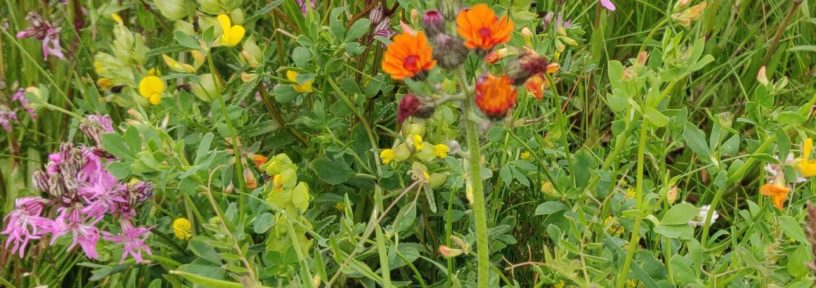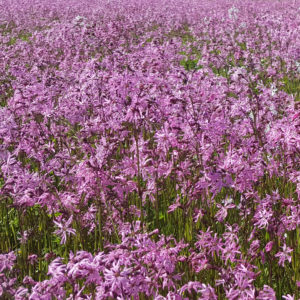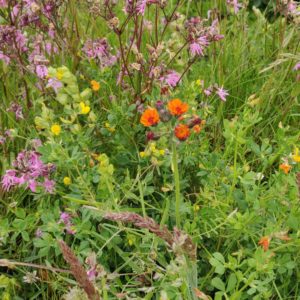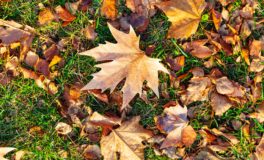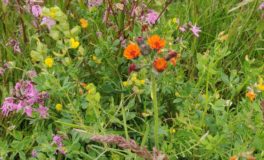Here is our Meadowmat Wildflower Turf Maintenance Guide. Compared to most garden features, a wildflower meadow is incredibly low maintenance. But, your maintenance regime can make the difference between success and failure.
Traditional meadow management was always more about feeding farm animals for 12 months of the year rather than growing flowers and supporting wildlife. The biodiversity was just a happy side effect of the farmer avoiding chemicals and artificial fertilisers.
Turfonline’s recommended maintenance regime emulates pre-war farming techniques but with a bit of a twist to encourage more flowers and slightly less grass. It’s a bit more garden-friendly than the farmer’s version.
The 5 Principals Of Meadow Management
Turfonline’s recommended maintenance regime aims to do 5 things:
-
Reduce soil fertility.
As a general rule, the most beautiful wild flowers thrive on impoverished soil. If soil fertility is too high the grasses and the strongest wild flowers tend to out-compete the more delicate species. That’s why, to create wildflower meadow, you should always install Meadowmat or sow wildflower seeds on to poor soil.
-
Suppress the grasses.
Farmers need to encourage grasses to grow strongly. Most gardeners on the other hand like to see a higher proportion of flowers than grasses. By carefully timed mowing and nurturing grass suppressing species like yellow rattle, the Meadowmat maintenance regime aims to keep grasses under control. The ideal is to have enough grass to give all year round ground cover and provide food and shelter for wildlife, but not enough to out compete the wildflowers.
-
Conserve the wildflowers.
It’s important for a meadow maintenance regime to create the right conditions for wild flowers to thrive in. Soil nutrient levels must be kept as low as possible, shade and moisture levels should suit the plant species and the mowing regime must allow for the wild flowers to set seed.
-
Control and discourage unwanted species.
One of the advantages of Meadowmat is that it suppresses unwanted species from the moment it is installed. If a meadow has been created from seed however, it is inevitable that “weeds” will try to invade. It is also likely that seeds from unwanted plants will arrive on the wind or be dropped by birds. Don’t worry, weeds are rarely a major problem in a wildflower meadow, but timely weed control will keep your meadow looking good.






-
Encourage a wider range of species.
As your wildflower meadow matures, you may want to add in some extra species either by seeding, adding new plants or planting bulbs. Following our seasonal suggestions for jobs to do in the meadow will help you to make your wildflower meadow even more interesting
How it used to be…and how to manage a modern livestock meadow
The old farmers relied on animals to maintain their meadows. In spring and summer the grass would be left to grow. Then in June or July they would cut it down for hay. Between July and March livestock would graze on the meadow, disturbing the ground with their feet and returning some nutrients to the soil via their droppings.
This annual cycle of cutting and grazing would keep nutrient levels just right for wildflowers to survive alongside the grass. There would be enough grass to be turned into hay for winter feed. Farmers, animals, wildflowers and wildlife would be happy
On a large scale, this method still works well. If you have a pony, a goat, even a cow to graze your meadow, this is the way forward. And for horse-lovers, the lower nutritional value of a wildflower meadow may even help avoid laminitis!
Modern Wildflower meadow maintenance – perfect for parks and gardens
A garden mini-meadow, a local authority park, a roundabout or a school wildlife garden is unlikely to be home to a herd of grazing cattle. So wildflower gardeners need a slightly adapted meadow management regime.
Our Meadowmat Guide – Growing.
Allow your meadow to grow unchecked between early spring and late summer. It will flower and set seed just as nature intended.
Our Meadowmat Guide – Mowing.
When the seed heads are formed and most of the flowers have gone over, cut the vegetation down to about 10cm (4 inches) high. Let the cuttings dry on top of the sward – this takes a couple of days in hot weather – then remove all cuttings. Every last one. Dead material mustn’t be allowed to rot down into the soil, it will only increase soil fertility and you don’t want that! If you are growing wildflowers for their seed-heads – eg Meadowmat for Birds and Bees, delay mowing until late February/early March
Our Meadowmat Wildflower Turf Maintenance Guide – Sowing.
In autumn, you can over-seed with more flowering species if you wish. If grass is a problem, now is the time to sow yellow Rattle. Yellow rattle is a plant that will weaken grass plants and keep them in check.
Our Meadowmat Wildflower Turf Maintenance Guide – More mowing.
Run the lawn mower over your meadow a couple of times throughout the autumn and winter. Remember to keep the blades set high and the grass box ON. This will help to reduce soil fertility and keep the meadow looking neat. It also lets seeds and seedlings have enough light to germinate and grow.
